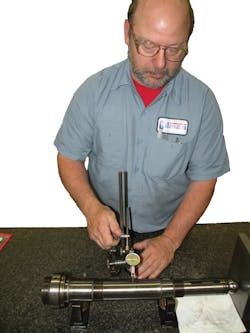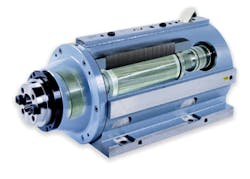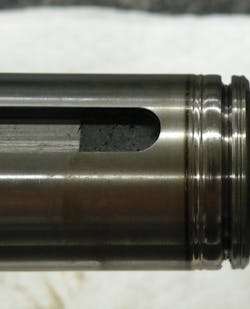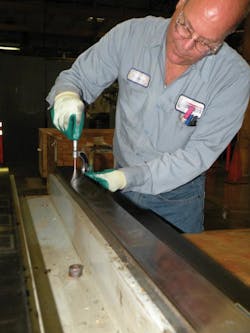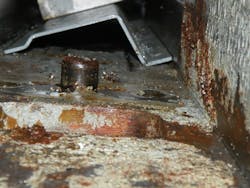The designs called spindles: Basics + best practices for servicing
Often designed as integrated units, spindles are applied in myriad applications. Several decades ago, spindles proliferated when engineers moved to replace hydraulic designs and manual operations.
Today, spindle designs are more sophisticated and customized, varying with the applications for which they’re used. Traditional designs feature power supplied from an electric motor via a belt-and-pulley system or gearbox; other spindles are built with the motor wrapped around the integrated design.
Drilling, boring, and milling are common machine tool uses. A typical machine-tool spindle is belt driven or motorized and works well in a variety of applications. Contamination such as rust chips or condensation is the main threat to machine-tool spindle performance.
Spindles are also used as robotic end effectors, allowing for carving or disc cutting of material, for example. Such robotic spindles are lightweight, operate at high speeds, and are generally motorized. Due to the weight-power-speed ratios, robotic spindles can be sensitive to unpredictable loads.
In the pharmaceutical industry, spindles drive high-precision mixers that ensure final drug consistency. Mixing spindles in these and similar applications incorporate stainless steel and food-grade grease. Due to the applications in which they operate, mixing spindles must be cleaned on a regular basis and must withstand imbalanced loads.
In test facilities, spindles are used on dynamometers. Dynamometer spindles feature high speed and high power — and are typically designed with permanent magnet motors, and able to withstand varying loads and speeds.
To understand the level of customization often found in today’s spindle design, consider the task of upgrading a five-DOF, tilting-head spindle used in aircraft engine manufacture to machine parts of Inconel, Titanium, and other aerospace alloys. Such designs often sport a two-spindle arrangement (a low-speed spindle to handle large tools and a high-speed spindle for small ones) that can complicate overhauls.
In this case, the slides are rebuilt, as brand-new replacement slides in existing applications generally aren’t necessary. Then, if appropriate, the complex spindle cartridge is simplified: Here and in similar applications, integrally motorized spindles sometimes offer better functionality than those relying on timing belts for coupling, while delivering the required speed and power. (Custom windings can be specified to fit within the head where space is limited.) Next, the head casting can be machined to let coolant circulate around the spindle body, allow the spindle to drop into the housing and bolt through a flange, and enable quick spindle removal for maintenance. To eliminate the problem of a hose band moving with the tilt head, the housing can also be inner-drilled and plumbed to handle all hydraulic, coolant, and electrical requirements.
Causes of spindle failure
A machine’s operating profile and the application ultimately determine spindle life, though exact predictions of when an unserviced spindle will fail are impossible. A machine operating 24/7 in a vigorous environment must withstand more use and abuse than one used for intermittent operation in a controlled environment.
Many factors contribute to failure, but leading causes are dirt, machining chips, and condensation that work their way into the spindle. For the latter:
• Common water-based coolants can cause rust to form inside the spindle.
• Spindle seals can also fail over time, leaving openings for other contaminants to enter.
• Thermal cycling can cause humidity to collect in spindles, particularly closed-unit types: Operation heats the machine, so that when the machine stops and cools, the resulting vacuum draws warm, humid air into spindle bearings.
Predictive maintenance and monitoring
Most spindle end-users don’t recognize that spindles require routine maintenance. Rather, spindle machinery often runs until problems develop.
A more proactive approach is to establish a routine maintenance program for the spindle system — including scheduled downtime to inspect, clean, and lubricate the system. In addition, vibration analysis on the spindle system can establish a baseline for performance; subsequent testing at periodic intervals can then reveal signs of trouble ahead. In fact, vibration analysis is most effective at catching problems early.
Employees working on or near spindles can also be the first to detect signs of spindle trouble, often in the form of unusual noises such as rattling or grinding.
The output of parts produced by the machine can also reveal problems, particularly if tolerances are off and not up to specification.
Once a spindle fails, an engineer has three options: Repair it in-house, have the spindle serviced, or purchase a new one.
Servicing industrial spindles
Spindles are the core of the machine into which they’re integrated, so when a spindle fails, operations stop — causing lost revenue. Spindle maintenance can keep such machines operating at peak capacity by minimizing productivity disruptions. More specifically, facilities running spindles can reduce unexpected downtime and costly new equipment purchases by sending spindles sent out for regular servicing.A few caveats: Most importantly, purchasing new is recommended when the spindle repair cost (parts and labor) approaches that of a new spindle. Also, some providers offer only basic spindle service, and don’t troubleshoot the entire system (including supporting equipment such as slides), though such procedures are necessary to identify the root of the spindle’s problem. For example, if the spindle is failing every couple of months, the problem may not be with the spindle itself, but rather something else — slides that are out of tolerance, for instance. In-house spindle engineers at qualified service providers will troubleshoot and recognize such issues.
• A comprehensive system review is critical to correctly identify spindle repair requirements, and ensure that those repairs optimize performance once completed.
• Refurbished or serviced spindles reinstall into existing systems more quickly than newly purchased designs.
• Refurbishing spindles costs about 40% less than purchasing new, and typically they can be back in service in less than a week.
Significant qualifications, equipment, and facilities are required for spindle servicing — in addition to expertise in how spindle systems are designed, how they operate in various applications, and how they work and interact with other equipment. At full spindle service facilities, class 10,000 cleanrooms with tightly controlled air quality (limiting the number of particles measuring 0.5 µm or greater for each cubic foot of air) also prevent bearing contamination. Providers with resources limited to simple lathes and grinders cannot offer such assurances.
Typically, spindle service begins with an engineer’s completion of a materials authorization form — essentially a questionnaire about the spindle type, manufacturer, serial number, nature of application, and suspected cause of failure. The goal is to supply as much information as possible about the spindle system to the provider, streamlining the troubleshooting and repair process.
When the spindle is received, an analysis is performed, the problem is identified, and a quote is provided on recommended repairs. Once the scope of work and quote is authorized, service begins.
The time required for outsourced spindle service depends on the spindle type. A belt-driven spindle that involves replacing seals and bearings can be serviced and back in operation in a few days. A motorized spindle, which involves analyzing the motor, removing moisture, replacing the stator and windings, and other tasks, is more complicated and can take longer.
A repaired spindle generally comes with a warranty.
Chris Hetzer is a mechanical engineer, CEO and partner at Gilman USA LLC. For more information, visit gilmanusa.com or call (800) 445-6267.
Spindles are often paired with slides to execute multi-axis application tasks — and these linear-motion devices can take a beating during normal operation. Cleanliness is the best way to keep slides operating well. Tip: During routine maintenance on the spindle system, lubricate the slides and brush dirt and debris off the slide covers as well. Such tasks take very little time.
Once damaged, slides can degrade spindle performance or even cause their failure — often without being suspected. For example, parts manufactured out of tolerance could be caused by slides not properly holding spindle position.
Therefore, when a spindle system is getting serviced, slide servicing should also be considered. Most engineers aren’t aware that slides can be repaired, so they typically replace them when performance lags. However, slides are relatively simple in design, so their repair process is simple as well. Few service providers have the equipment necessary to make slide repairs, so this service isn’t widely available — but slides that are repaired provide years of service at about half the cost of new ones.
